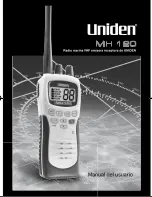
6
6
2 Channel Information
2.1 Overview
You can program Channels in “Edit > Channel
Information > Channel Edit” in the FPU.
The maximum number of channels is 64.
2.1.1 Receive
Frequency
You must program the transceiver receive frequency
within the range of permitted frequencies.
2.1.2 Transmit
Frequency
You must program the transceiver transmit frequency
within the range of permitted frequencies.
2.1.3 QT/DQT
QT/DQT is the Signalling used to facilitate
communication within a Group when sharing the
same channel with several groups (Talk Group).
Using this type of signalling, you do not need to hear
unwanted communications.
The transceiver mutes unwanted calls that are
programmed with different QT/DQT settings.
QT/DQT Signalling uses frequencies outside the
voice frequency range so that it does not interfere
with communications.
The transceiver can distinguish the Signalling, which
is a continuous wave form, even if reception begins
midway through a transmission.
The Squelch Tail Eliminator, when using QT/DQT,
eliminates the noise burst heard by the receiving
party from the transmitting party radio.
QT
QT (Quiet Talk) uses a continuous sub-audible
sinewave (67.0 Hz ~ 254.1 Hz).
The Reverse Burst function that reverses the
phase of the sine wave works as the Squelch Tail
Eliminator.
DQT
DQT (Digital Quiet Talk) uses a 23-bit binary
number.
You can program the DQT code from 023 ~ 754 in
Hexadecimal.
The DQT signal has polarity and can be programmed
as either Normal or Inverse, corresponding to a
repeater or the circuit configuration of the other
transceiver. The Squelch Tail Eliminator when using
DQT reverses the polarity from what is currently
being used.
When the received QT/DQT code matches the
QT/DQT code programmed in the transceiver, the
speaker unmutes.
The speaker mutes when the transceiver receives a
Reverse Burst (QT) or a Turn Off Code (DQT).
2.1.4 QT/DQT
Encode
The transceiver transmits the QT/DQT code
programmed in the transceiver when the PTT switch
is depressed.
The Reverse Burst in QT and the Turn Off Code in
DQT are transmitted for 176 ms after releasing the
PTT switch.
2.1.5 Channel
Name
The programmed channel may have a name
assigned to it using the FPU.
The Channel Name allows you to easily identify the
caller (Ex. “BASE”, “DELIVERY”, “FRONT”,
“PORTER”).
You can program up to 8 characters for the Channel
Name using the following characters:
(space) # $ % ( ) * + , - / 0 1 2 3 4 5 6 7 8 9 = @ \ _ A
B C D E F G H I J K L M N O P Q R S T U V W X Y Z
The Channel Name appears in “Optional Features >
Display Character > Channel Name” of the FPU.
2.1.6 Wide/Narrow
You can select 25 kHz (Wide Bandwidth) or 12.5 kHz
(Narrow Bandwidth) for the bandwith of each
Channel.
2.1.7 TX
Power
This function allows you to set the transmit power
output for each Channel to either High or Low.
2.1.8 Option
Signalling
Option Signalling is used for receiving calls from the
Dispatcher.
Option Signalling may include “DTMF”, “2 Tone” and /
or ”MSK”; the TK-7100H/8100H uses “DTMF” for
Option Signalling.







































